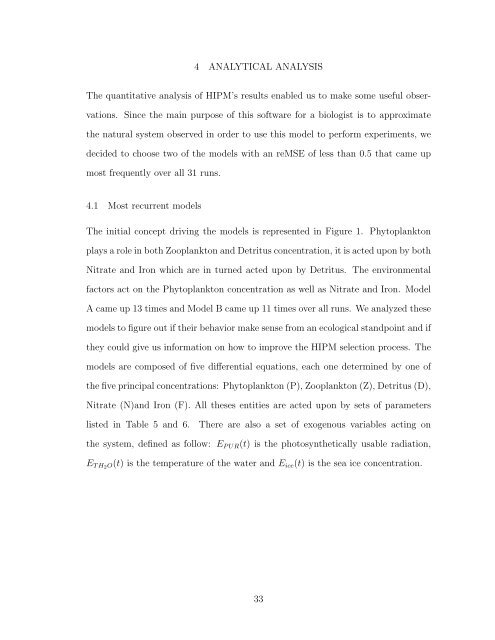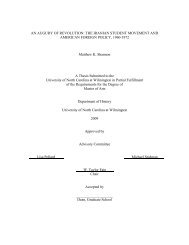HIERARCHAL INDUCTIVE PROCESS MODELING AND ANALYSIS ...
HIERARCHAL INDUCTIVE PROCESS MODELING AND ANALYSIS ...
HIERARCHAL INDUCTIVE PROCESS MODELING AND ANALYSIS ...
Create successful ePaper yourself
Turn your PDF publications into a flip-book with our unique Google optimized e-Paper software.
4 ANALYTICAL <strong>ANALYSIS</strong><br />
The quantitative analysis of HIPM’s results enabled us to make some useful observations.<br />
Since the main purpose of this software for a biologist is to approximate<br />
the natural system observed in order to use this model to perform experiments, we<br />
decided to choose two of the models with an reMSE of less than 0.5 that came up<br />
most frequently over all 31 runs.<br />
4.1 Most recurrent models<br />
The initial concept driving the models is represented in Figure 1. Phytoplankton<br />
plays a role in both Zooplankton and Detritus concentration, it is acted upon by both<br />
Nitrate and Iron which are in turned acted upon by Detritus. The environmental<br />
factors act on the Phytoplankton concentration as well as Nitrate and Iron. Model<br />
A came up 13 times and Model B came up 11 times over all runs. We analyzed these<br />
models to figure out if their behavior make sense from an ecological standpoint and if<br />
they could give us information on how to improve the HIPM selection process. The<br />
models are composed of five differential equations, each one determined by one of<br />
the five principal concentrations: Phytoplankton (P), Zooplankton (Z), Detritus (D),<br />
Nitrate (N)and Iron (F). All theses entities are acted upon by sets of parameters<br />
listed in Table 5 and 6.<br />
There are also a set of exogenous variables acting on<br />
the system, defined as follow: E P UR (t) is the photosynthetically usable radiation,<br />
E T H2 O(t) is the temperature of the water and E ice (t) is the sea ice concentration.<br />
33
















